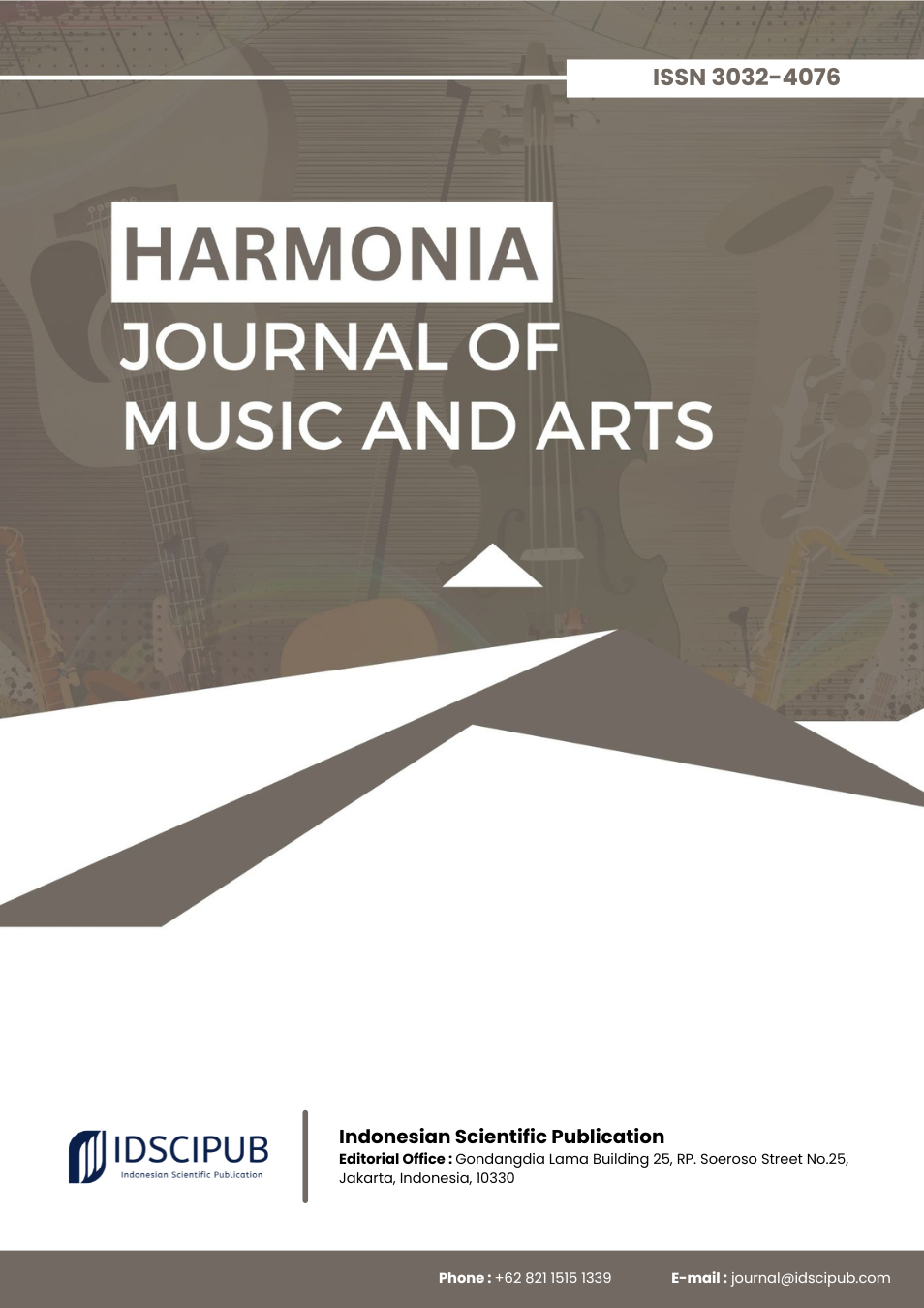Music, Identity, and Social Justice: A Narrative Review of Contemporary Approaches
DOI:
https://doi.org/10.61978/harmonia.v2i1.895Keywords:
Music Education, Music and Identity, Cultural Influence of Music, Critical Pedagogy in Music, Music and Social Justice, Digital Platforms in Music, Global Music StudiesAbstract
Music is a fundamental cultural practice that extends beyond entertainment to shape identity, education, and social justice. This narrative review aims to synthesize contemporary scholarship addressing how music functions as a tool for personal and collective identity construction, pedagogical transformation, and sociocultural engagement. A systematic literature search was conducted using Scopus, PubMed, and Google Scholar, employing keywords such as “music education,” “music and identity,” “cultural influence of music,” “critical pedagogy in music,” and “music and social justice.” Inclusion criteria prioritized peer-reviewed studies published in the last two decades that demonstrated methodological transparency and thematic relevance. The results indicate that music significantly influences identity formation, with empirical evidence showing measurable effects on racial and cultural perceptions among youth, while qualitative studies emphasize the role of pedagogies that foster autonomy and social awareness. Comparative studies highlight the universality of music’s identity-shaping role while also underscoring variations across cultural and geographic contexts. Discussion reveals that systemic factors—including inequitable access, exclusionary curricula, and limited representation—pose challenges to realizing music’s full potential. Inclusive pedagogical strategies and policy reforms are identified as promising pathways to address these barriers, though their effectiveness requires further empirical validation. The review concludes that music is both a cultural and educational resource with profound implications for fostering equity and inclusion. Future research should adopt multi-methodological designs, expand to non-Western contexts, and investigate digital influences on music consumption and identity. These directions are essential for advancing music’s role in education and social justice.
References
Attas, R. (2019). Music theory as social justice: pedagogical applications of Kendrick Lamar’s To Pimp a Butterfly. Music Theory Online, 25(1). https://doi.org/10.30535/mto.25.1.8 DOI: https://doi.org/10.30535/mto.25.1.8
Carless, D., Douglas, K., Barnes, J., & Pineau, E. (2024). Sand in sculpture: creatively rewilding ecologies of health. Qualitative Inquiry, 31(2), 165-174. https://doi.org/10.1177/10778004241229786 DOI: https://doi.org/10.1177/10778004241229786
Casellas, M. (2021). The conservatory debated from a critical pedagogy perspective. International Journal of Music Education, 40(2), 217-227. https://doi.org/10.1177/02557614211034189 DOI: https://doi.org/10.1177/02557614211034189
Gioffredo, M. (2024). Seizing the life of sounds in contemporary instrumental music: Claude Vivier’s Zipangu (1980), a spectromorphological perspective. Music & Science, 7. https://doi.org/10.1177/20592043241303260 DOI: https://doi.org/10.1177/20592043241303260
Ito, J. (2012). Koch’s metrical theory and Mozart’s music. Music Perception, 31(3), 205-222. https://doi.org/10.1525/mp.2014.31.3.205 DOI: https://doi.org/10.1525/mp.2014.31.3.205
Kolesnikov, A. (2022). Cranes, drones and Eisenstein. Projections, 16(1), 25-46. https://doi.org/10.3167/proj.2022.160103 DOI: https://doi.org/10.3167/proj.2022.160103
Koutsomichalis, M. (2017). Ad-hoc aesthetics: context-dependent composition strategies in music and sound art. Organised Sound, 23(1), 12-19. https://doi.org/10.1017/s1355771817000231 DOI: https://doi.org/10.1017/S1355771817000231
Lee, D. (2018). ‘Negeri seribu bangsa’: musical hybridization in contemporary Indonesian death metal. Metal Music Studies, 4(3), 531-548. https://doi.org/10.1386/mms.4.3.531_1 DOI: https://doi.org/10.1386/mms.4.3.531_1
Maxwell, M., Abrams, J., & Belgrave, F. (2016). Redbones and earth mothers: the influence of rap music on African American girls’ perceptions of skin color. Psychology of Music, 44(6), 1488-1499. https://doi.org/10.1177/0305735616643175 DOI: https://doi.org/10.1177/0305735616643175
Polak, R., London, J., & Jacoby, N. (2016). Both isochronous and non-isochronous metrical subdivision afford precise and stable ensemble entrainment: a corpus study of Malian jembe drumming. Frontiers in Neuroscience, 10. https://doi.org/10.3389/fnins.2016.00285 DOI: https://doi.org/10.3389/fnins.2016.00285
Psomadaki, O., Matsiola, M., Dimoulas, C., & Kalliris, G. (2022). The significance of digital network platforms to enforce musicians’ entrepreneurial role: assessing musicians’ satisfaction in using mobile applications. Sustainability, 14(10), 5975. https://doi.org/10.3390/su14105975 DOI: https://doi.org/10.3390/su14105975
Rymer, J. (2017). An argument for investigation into collaborative, choreomusical relationships within contemporary performance: a practical and theoretical enquiry into the distinct contributions of a collaborative, co-creative approach. Avant: The Journal of the Philosophical-Interdisciplinary Vanguard, VIII(Special), 181-196. https://doi.org/10.26913/80s02017.0111.0017 DOI: https://doi.org/10.26913/80s02017.0111.0017
Schofield, K. (2021). Emotions in Indian music history: anxiety in late Mughal Hindustan. South Asian History and Culture, 12(2-3), 182-205. https://doi.org/10.1080/19472498.2021.1878792 DOI: https://doi.org/10.1080/19472498.2021.1878792
Ulusoy, E., & Fırat, F. (2016). Toward a theory of subcultural mosaic: fragmentation into and within subcultures. Journal of Consumer Culture, 18(1), 21-42. https://doi.org/10.1177/1469540516668225 DOI: https://doi.org/10.1177/1469540516668225
Yıldız, E. (2025). Kültürlerarasi tiyatroda geleneksel kaynaklar ve müzik kullanimi. Yegah Müzikoloji Dergisi, 8(1), 748-776. https://doi.org/10.51576/ymd.1630522 DOI: https://doi.org/10.51576/ymd.1630522
Yudarta, I., Beratha, N., & Sudirga, I. (2025). Actualization of the spirit of nationhood in karawitan musical compositions by Balinese maestro I Wayan Beratha. Jurnal Kajian Bali (Journal of Bali Studies), 15(1), 314. https://doi.org/10.24843/jkb.2025.v15.i01.p12 DOI: https://doi.org/10.24843/JKB.2025.v15.i01.p12






